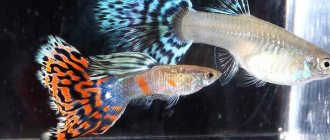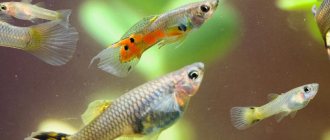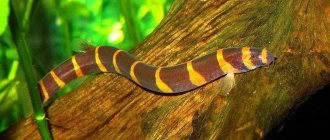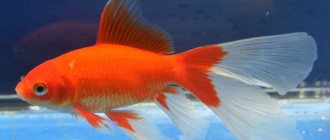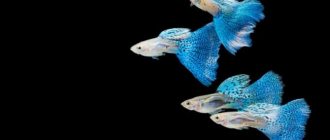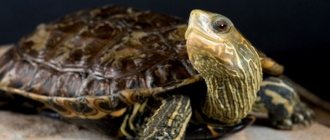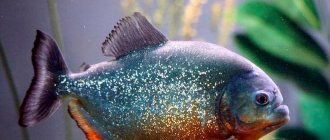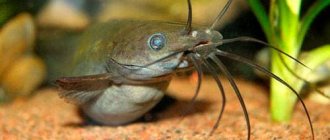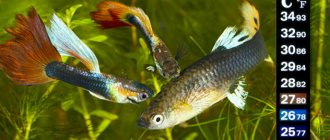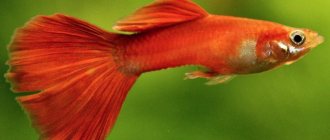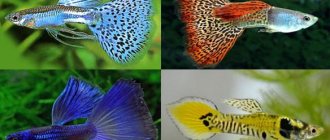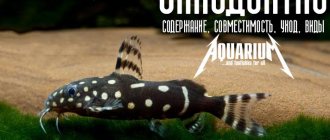Red guppies
This group can include all guppies that are red in color, but have a variable pattern - this is a solid red color, red blond guppy, red dragon guppy, red mosaic, red platinum, red-black, red Tuxedo, red Moscow, flamingo guppy, scarlet, red snakeskin, etc.
Red snake skin guppy
Red cobra guppy photo
Red dragon guppy photo
Super red guppy photo
Guppy red blond photo
Guppy flamingo photo
Reproduction
Guppy is a viviparous fish. It reproduces easily in an aquarium without special preparations. However, if you want to breed quality guppies, selective breeding is necessary.
Choose a pair of guppies whose color, size and fin shape you like. Males can be identified by their brighter colors, are smaller than females, and have a small, thin anal fin used for fertilization called the gonopodium.
The female carries the fry for approximately 21-27 days. Closer to childbirth, the belly becomes slightly rectangular in profile, with corners prominent in front and behind. Form is assessed before feeding. The female also begins to behave restlessly, swim up and down, and generally unusual. Sometimes he refuses to eat. Just before giving birth, he tries to hide somewhere.
After they have reproduced, select and remove the male and female or several females that you like best, and so on.
Guppies are black
This group includes black guppies under loud names such as: black monk, black prince, black tuxedo, black Moscow. The problem with this group is the difficulty of selectively retaining black tones. Therefore, good black specimens of guppies are highly valued by aquarists.
Guppy black monk photo
Black Moscow Guppy photo
Guppy black prince photo
Black Tuxedo Guppy photo
Guppy solid black photo
Behavior
These are very peaceful fish; conflicts between guppies and other species can be counted on one hand. The main reasons for conflicts between guppies are the fight for a female or poor living conditions. They almost never act as an aggressor with other fish; however, other moderately aggressive fish often attack guppies. Therefore, it is important to keep them in an aquarium with plenty of plants or other cover. On the other hand, guppies can be bred as live food for larger fish.
Guppy green
Green cobra, green Moscow guppy, snake skin +++
Green Moscow guppy photo
Green snake skin guppy photo
Guppy green cobra photo
Price
Aquarium fish can be purchased at pet stores or online to order. The average price of a guppy fish is 80 rubles, but sellers determine the lower and upper limits depending on the type, size and external appearance of the fish. Individuals that meet international selection standards take part in competitive exhibitions.
A small, peaceful and cute guppy fish is a wonderful pet for your home. It does not require large expenses and does not cause any problems. While caring for a guppy fish, we gain experience and simply enjoy the peaceful spectacle.
If you liked the article, leave comments and share a link to it on social networks.
Guppy yellow
This group includes all guppies with predominant yellow tones: yellow tuxedo, yellow cobra...
Yellow and then white, albino breeds, all these are xanthorist - aquarium discoloration mutations. Their breeders fix them genetically. Xanthorists are fish that are discolored by developing a yellow tint instead of red or green. Yellow guppies are xanthorista. White, albinos are super xanthorist freaks. All these are scientific terms without any hype. A freak is an individual with congenital body defects, possibly due to a genetic defect or exposure to negative factors in the embryonic period. And period.
And you say that GLO-fish is wow wow. Here, before Glo, how much wood humanity has chopped up, so mother, don’t worry.
Guppies yellow Berlin photos
Guppy yellow cobra photo
Yellow Tuxedo Guppy photo
Keeping at home
The ease of keeping guppies at home does not relieve the breeder of the obligation to follow the basic rules of caring for them.
In order not to complicate the task of caring for yourself, it is worth initially choosing and arranging the right place of residence for the fish, creating conditions for its comfortable living. The rules are written below.
Which aquarium to choose?
Despite its small size, the fish is very prolific. Therefore, when choosing an aquarium, it is worth taking this factor into account. The following rule should be followed: there should be no more than 5 guppies per water volume of 20 liters.
The above criterion assumes that males and females live together. To successfully start breeding from 10 guppies, a 60 liter aquarium is quite suitable.
Another advantage of a large aquarium is that it does not need to be washed frequently (provided a filtration system is installed). If you want to introduce only a few males into the “pool” (they are distinguished by their bright colors), a large aquarium is not required.
Water requirements
To keep the species comfortable, it is important to maintain a temperature suitable for survival. Guppy is a tropical fish species, which means it loves warm water environments. The ideal constant water temperature is + 23°C.
The survival range ranges from +16 to +30°C. At low temperatures, the possibility of getting sick increases, and at high temperatures, the fish live only about a year and grow small.
It is worth paying attention to other indicators of water. The standard pH for comfortable living is from 7 to 8.5. Water hardness is from 12 to 18°F.
In addition to regularly maintaining the cleanliness of the water (washing the container), it is necessary to purchase an aquarium internal filter. The simplest device that performs its functions as standard (mechanical, chemical and biological water purification) will do.
For fish to exist, there must be sufficient oxygen in the water. The process of saturating a liquid medium with vital gas is called aeration.
The following types of aeration exist:
- Artificial. These are purchased devices. Their advantage: in addition to enriching the water with oxygen, they create vortex flows that mix the layers of water (no stagnation occurs). Additionally, aerators cause a weak current. This brings aquarium conditions closer to the natural habitat of guppies.
- Natural. These are plants (algae). The advantage of using them is the release of oxygen naturally during photosynthesis.
The best option is to use both types of oxygen supply to water.
Another condition for a comfortable life for fish is regular replacement of water with fresh water. It is not necessary to completely drain the liquid. It is enough to scoop out 15–30% of the total volume and pour in clean, settled water.
There are some nuances here. Based on the periods of use of the aquarium, replacement occurs according to the following schedule:
- Up to 3 months. When creating a new ecosystem, you should not change the water for 90 days. At this time, a microclimate is formed.
- Up to 1 year. After 3 months up to 1 year, you should change the water in a volume of 20% at intervals:
- once a month if there is no filter;
- once every month and a half, if the filter is available.
- Up to 2 years. When keeping an aquarium for 1 to 2 years, the water is changed in the same volume, but twice as often.
- More than 2 years. Alternating every 2-3 weeks, it is necessary to replace the water in a volume of 25% and thoroughly clean the entire aquarium. This regime is followed for 2 months. Then, for a period of 8–10 months, they return to a care regimen focused on 2 years.
Step-by-step algorithm for partial water changes:
- Pour tap water into plastic buckets. Leave to settle for 3–15 days. The duration depends on the water quality in a particular region. It is better to wait longer and be sure that the water is ready for change.
- Temporarily transfer the fish to a clean jar of water. Use a net.
- Using an aquarium siphon (soil cleaner), pump out the required amount of water, filtering the soil.
- Slowly pour the settled water into the aquarium.
- Let the filter work for a while. It will remove contaminants from the “disturbed” water.
- Move the fish to their familiar environment.
Lighting
The intensity and duration of aquarium lighting is of great importance for the health and existence of fish. Deficiency leads to deterioration of immunity and curvature of the spine.
In summer, daylight hours are 12–14 hours (natural light is included during the period). Direct sunlight should not hit the walls of the aquarium. They promote the development of harmful algae. In winter, the total duration of illumination has a limit of 11 hours.
For additional light, it is optimal to purchase a 15-volt lamp. This power is suitable for an aquarium with a volume of 20 liters. Larger aquariums will require a more powerful lamp.
Soil and plants
Another factor in a prosperous life for guppies is soil and plants. There are no special requirements for the filler. The only rule is that it should not have sharp edges (the fish get hurt). The best option is natural soil with a fraction of 3–5 mm.
Small stones are required to anchor natural plants to the bottom. In addition to performing the functions of an aerator, vegetation creates living conditions for fish that are close to natural.
The most popular aquarium plant is the Indian fern. It becomes a decoration of the aquarium and serves as a refuge for the fry. Other types of greens are cabomba, ludwigia, vallisneria, echinodorus, anubias.
White guppies
Albino guppy photo
White Moscow guppy photo
White platinum guppy photo
Results
The aquarium fish guppy is bright, beautiful and looks especially good when it lives with its brothers. They are unpretentious, which makes them perfect for beginner aquarists, and everyone has at least once dreamed of owning this daredevil. If you want to find out who you can share with her, then read our article on the compatibility of guppies with other fish.
Previous
Fish How many aquarium fish are compatible with the betta fish?
Next
Fish Sturisoma Panama - a picky catfish for beginners
Guppy cobra
And finally, let’s highlight two more popular morphs of the common guppy, the qualification for which is the body pattern. Cobra guppies are all guppies with “snake skin”.
Guppy cobra blue photo
Guppy cobra green photo
Yellow cobra guppy photo
Red cobra guppy photo
Guppy Cobra Ceylon photo
Habitat
Guppies were first discovered in South America, more precisely in its northern part. The natural range is not so small: these fish are found on the islands of Trinidad and Tobago, Venezuela and Brazil, their populations occupy a significant part of the Amazon River basin. The homeland of guppies is characterized by a hot and humid climate, as well as a large number of fresh rivers. Fish prefer river and lake water, but easily adapt to cold high-mountain streams. They live in swamps and in muddy artificial canals, but not in sea water.
This is interesting! It is noteworthy that the diet of wild guppies includes the larvae of malaria mosquitoes. To combat these insects, small fish were distributed throughout warm water bodies around the world.
